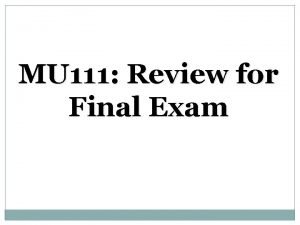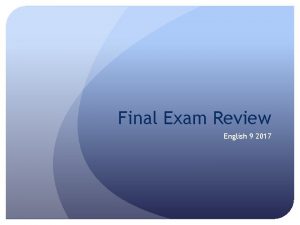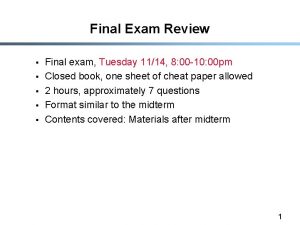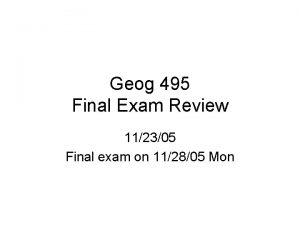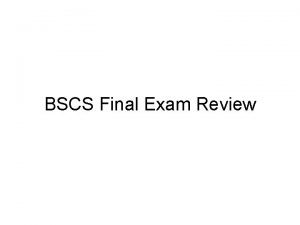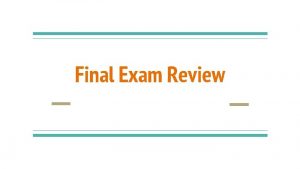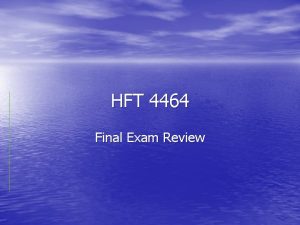Final Exam Review Introduction The exam is not














- Slides: 14

Final Exam Review

Introduction • • • The exam is not comprehensive, that can change. Equations are given, check: http: //courses. washington. edu/cive 316/cover. doc greater weight will be given to exact solutions. Questions mainly of the types: True or False, analytical problems, illustrate, what is? … • Expect questions about the GPS demo. • This lecture is to review the second part topics only.

Horizontal Curves • • Horizontal: types, definitions, and uses Curve relations Station Equation Laying out by deflection formula, check the project • Sight distance on a horizontal Curve

Vertical Curves • Design Criteria • Equation of the parabolic shape in surveying terms, why parabolic? • Computations using the tangent offset equation • High or low points on a curve • Designing a curve to pass by a point • Sight distance sag and crest? • Safe length of the curve

Coordinate Systems • Relationship between geodetic and SPCS • Relationship between geodetic and grid azimuth • review USRS, Geodetic and SPCS basics • Surveys extending from one zone to another

Surveys of the Public Lands • PLSS: why ? where? accuracy considerations • System divisions: quadrangles, townships, sections, quarter sections, what are the corners? • System construction: Initial point, Principal Meridian, Base Line, Standard Parallels, Guide Meridians, Closing Corners, Standard corners, range and township lines. • In addition to understanding the system, you are expected to know how to draw sketches, compute distances, and decide which lines bound what division “ PM, GM, B. L, S. P bound quadrangle”, and so on.

Boundary Surveys • Why ? • Different methods: – Metes and bounds: must mention certain info: point of beginning, definite corners, lengths and directions, neighbors, areas – Block and Lot: lot numbers, map books. – Description by coordinates.

Construction Surveys • • • Stages: design, construction, and after construction. Equipment: lasers, levels, total stations, GPS. Control: before and during construction. Staking out buildings, batter boards locations ? Checking plumbness Using a total station in construction surveys: first orient it, then use it to stakeout

GPS • How to find the position of the receiver, what distances being measured. • Satellite constellation and ephemeris (broadcast and precise) • Signals: two carrier waves, two PRN codes, why? and additional data • What are: C/A, AS, SA, cycle ambiguity? • demo

• Position determination: –Pseudoranging: using codes. –By carrier wave measurement • Field procedures: Static, rapid static, kinematic, pseudokinematic, real time kinematic • Errors: ephemeris, atmospheric effect, receiver errors, multipath, centering, and elevation. • Coordinate system considerations: satellite to USRS, to geodetic, then to whatever system • Planning a GPS project: how to read the tables and polar maps • Try to remember what we did in the field

Theory of Measurements and Errors • Types of errors and how they behave. How to adjust them. • Precision and accuracy • Errors and probability distribution. • standard deviation as a measure of precision • Error propagation: the law and how to apply it. Review how to derive basic functions. The law of error propagation will be given.

Photogrammetry • Review camera components. • Geometry of vertical photos: image coordinate system, PP, exposure station. • side and end lap, strips and blocks. • Scale: at a point, photo average scale, from a map. • Ground coordinates: special system, just multiply photo coordinates by the scale. • Relief displacement, how to use it to compute object heights • Stereoscopic Parallax: what is it, why is it important, how parallax equations could be used. • Stereoscopic viewing: theory and conditions for stereo viewing. How did you see stereo in the demo? • Plotters, orthophotos, and ground control: read them.

Remote Sensing • The electromagnetic spectrum, why can we see in sun light and not on earth’s emitted energy? • Spectral reflectance: how to use to distinguish different objects. what is spectral signature? • Why do we see trees green, … • main earth resource satellites: Spot and Land. Sat, spectral VS spatial resolution

GIS • • What is a GIS? Layers concept Spatial and non spatial data Analytical functions: buffering, adjacency and connectivity, overlay, . . • Difference between GIS and LIS?
 Writ of certiorari ap gov example
Writ of certiorari ap gov example World history spring final exam review answers
World history spring final exam review answers Spanish packet answers
Spanish packet answers Pltw human body systems final exam
Pltw human body systems final exam Truss practice problems poe
Truss practice problems poe Ied final exam review
Ied final exam review World history first semester exam review
World history first semester exam review Principles of business final exam answer key
Principles of business final exam answer key Bm3final
Bm3final Environmental science defination
Environmental science defination Ap world history final exam
Ap world history final exam Us history final exam semester 2
Us history final exam semester 2 English semester 2 final exam
English semester 2 final exam Physics 20 final exam practice
Physics 20 final exam practice Physical science jeopardy
Physical science jeopardy




















